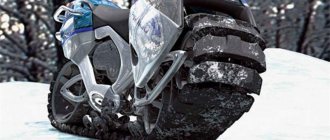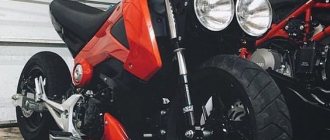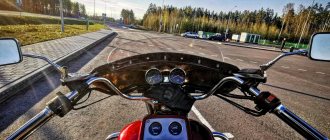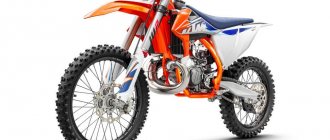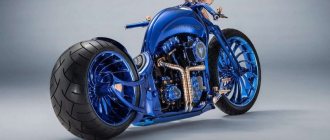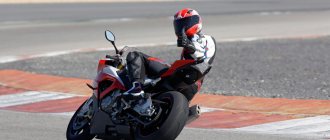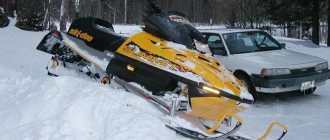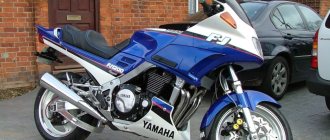The most traumatic part of the car is the bumper, since it is most often scratched, beaten and subjected to mechanical stress. And often, when purchasing a new bumper, you need to paint it to match the color of the car. Painting can be done with your own hands; to do this, you should study the painting technology or watch videos of experienced craftsmen. Typically, this part of the car is made of plastic, which has various properties. Therefore, before you get ready to paint a new bumper, you should study the features of the material itself. This way the part will be painted with high quality and in the shortest possible time.
Features of the material
Plastic and plastic are various synthetic materials that have a certain composition and set of properties. The material used in the production of a car comes in two types. The first is the one that needs to be primed before painting, and the second is the one that does not require additional actions.
Before you paint a part with your own hands, you should first find out the type of plastic. This will help prevent paint from peeling off the part in the future. You can check this information with the seller, study the labeling, watch a video on the Internet, or check it yourself.
There are two ways to help you choose the required repair technology depending on the type of plastic.
- Burning - you need to set fire to a small piece of material and watch the smoke. If black smoke and soot appear, it means that painting is possible without additional priming. When the flame is clean, you need to apply additional primer for plastic.
- Buoyancy - if the part is completely immersed in water, then no additional priming is required. If it floats on the surface, you need to prime the surface.
Once the type of plastic has been determined, you can begin painting the bumper.
Antistatic treatment
Most plastics do not conduct electricity well or are insulators at all. As a result, they tend to accumulate a static charge, which attracts dust and small particles of debris. Static electricity is more likely to occur when air humidity is very low. This is especially noticeable in winter, in the presence of “drying” heating. Keeping air humidity above 50% will reduce the likelihood of static charging.
If there is static electricity on the plastic, wiping with a tack cloth may not remove all the debris.
Water helps remove static charge. Therefore, already at the washing stage, static electricity on the plastic is reduced. This is another useful property of washing before painting.
If there are signs of static electricity on the plastic, you can additionally use a homemade antistatic agent: 8 parts distilled water + 2 parts isopropyl alcohol. You can apply the product using a brush (or brush) with soft bristles dipped in this product. Next, you need to wipe the surface with a lint-free cloth and dry it with compressed air. Dust will stop sticking to the bumper.
Painting technology
There is a certain technology thanks to which painting a new bumper yourself will be done efficiently and quickly. There are several sequential steps that are required if you want to paint this part of the car yourself:
- preparation of workshop and details;
- degreasing;
- if necessary, applying primer to plastic;
- applying basic primer (acrylic);
- painting with a base color;
- applying varnish.
Preparatory work
Before painting the part, you need to do some preparatory work. So, do-it-yourself painting begins with preparing the workshop and the surface itself. The final result depends on how well these procedures are carried out.
The room in which you will paint the bumper yourself must have good lighting in order to see the smallest defects. The next important criteria are cleanliness and ventilation.
The surface of the part must be wiped with a damp cloth to remove dust or other contaminants. The new bumper has a special factory coating that cannot be painted. Therefore, you need to remove this coating using sandpaper. Painting of car parts, especially if it is done by Chinese manufacturers, is carried out only after thoroughly degreasing the surface. This is explained by the fact that the molds in which they are cast are heavily lubricated with silicone. Therefore, high-quality painting of such a part will not be possible.
What you need to prepare
Before you start preparing the bumper for painting, you need to first stock up on everything you need. You must have:
Tools:
- a soldering iron (100W) is needed if it is necessary to first repair the bumper;
- different spatulas;
- a grinding machine or drill with special attachments (you can, of course, do all the work by hand, but this will require much more effort);
- spray gun (not needed if painting will be done from spray cans);
- pressure regulator;
- dehumidifier. This filter is installed directly in front of the spray gun;
- protection for humans - respirator, gloves and clothing.
Materials:
- sandpaper of different types - moisture-resistant square and circular for a grinding machine. It is highly desirable to have P180, P240, P320, P400 and P600;
- fiberglass;
- adhesive composition – two-component;
- solvent;
- degreaser;
- putty;
- primer for plastic;
- paint, approximately 250 g;
- varnish (two-component);
- measuring container.
Important! The primer, putty, paint and varnish must belong to the same manufacturer, since some time after the repair, peeling may occur due to the incompatibility of the components included in their composition.
Applying primer for plastic
To prime plastic with your own hands, you will need a special Velcro primer containing a plasticizer. It comes in a transparent color and with a silver filler, the advantage of which is its visibility on the surface.
The primer for plastic is sprayed using a spray gun and it will take no more than 30 minutes to dry completely. It is applied in 1-2 layers with an interval for drying. If sprayed excessively, leaks may occur. Once completely dry, no additional sanding is required.
We paint a new plastic bumper from a spray can
Previously, if it was necessary to replace a body part, the only option was to purchase a contract part at a car dismantling station or second-hand. This method has its disadvantages:
- it is very difficult to select a contract part that exactly matches the color of the car, and in addition to the cost of the part, you will have to pay for painting;
- a contract part may not be a contract part, but a used one; when repainting, a different color, putty, hidden damage may be discovered under the top layer of paint, and the cost of repainting will increase taking into account the repair.
A contract spare part is a part removed from a car that has no mileage in Russia. Let's say a Japanese car was used in Japan for several years, then the owner decided to exchange it for a new one, and the old one was sent to Russia to be sold for spare parts. Purchasing contract spare parts from a reliable company is a transparent transaction. You are provided with reliable information about the part; you can often see a photo of the car from which the part was removed, mileage, and an auction sheet with an estimate. The auction list always honestly states the condition of the car, and if any part has been repainted, the seller will know about it. But there are also cases when, intentionally, or simply without making a distinction, under the guise of a contract, the seller offers a used part - it has already been used in Russia, its history is unknown, and its condition can only be assessed visually. If it comes to auto body work, and you are not an expert in this field, there is a risk of buying just such a part, especially when it comes to a spare part, the reverse side of which cannot be seen without disassembling (for example, a door assembly with trim).
Today, the situation with the purchase of body parts has improved: companies have appeared that produce new body parts, and stores where these products are presented in an assortment. New parts, compared to contract ones, are inexpensive. Even if there is no such store in the city, you can order the product via the Internet, and be sure: you will receive a new part that has not been painted or repaired before.
Painting a new bumper is a real pleasure and doesn’t take much time or effort. The consumption of materials will be minimal, and difficulties in work can only arise due to your own mistakes.
What you will need:
- primer in a can (for plastic)
- spray paint
- varnish in a can
- degreaser
- antistatic
- clean cotton rag
- sandpaper P800
- bucket with water
- gloves
- sponge
- respirator (mask)
- protective glasses
- work clothes
The primer comes in different colors: white, different shades of gray, black. Despite the fact that the paint will completely cover the primer, choose the color of the primer based on the color of the paint: for light shades - light primer and vice versa. When selecting materials, carefully read what the manufacturer writes on the can about applicability, rules of use, and drying time. When selecting paint, be guided by the color code indicated on the plate under the hood; if the car was repainted in a different color, contact a colorist to mix the paint according to the sample. For a sample, the easiest way is to remove the gas tank flap.
Choose a suitable room. A suitable one is one in which there is no dust, ideally a paint booth. Many people do not attach any importance to this until they see that dust has settled on the product and all their work is in vain. When you work in a garage, at least try to cover the inside with film; if this is not possible, pour water on the floors. Place the bumper on a stand (for example, on a table) at a convenient height. Cover the stand with a soft cloth and film on top - this is necessary so as not to damage the fragile plastic with the corners. Choose a stand so that it rests against the middle part of the bumper at several points, but in no case rests against the edges: if during work you inaccurately press on the bumper, with such a support it may become deformed or crack.
The bumper is new, so it does not require special preparation for painting work. Rinse it with water, wipe it with a clean cloth, and cover it with an antistatic agent. Degrease, wait for the degreaser to dry completely, and begin priming. In order for the material (no matter whether primer, paint or varnish) to lay down evenly, always spray it at the same distance from the part. Start spraying outside the bumper, gradually moving onto it, and finish smoothly: do not make sharp boundaries in applying the material. Wait for the soil to dry completely. Degrease and add another layer of soil.
How to paint: step by step photos
This is what a non-original part looks like
Everything you need to paint a new bumper
First layer
Second layer
Two coats of paint
Two coats of varnish
Bumper on a car
As silly as it may sound, don't try to check with your fingers to see if the material is dry. Many beginners, wanting to finish the job quickly, try to check whether the next layer can already be applied. If a print on the ground is easy to remove, then getting rid of a mark on paint or varnish takes much longer than just waiting. Study the drying times indicated on the paint can, rely on these data, increased by 1.5–2 times, since your coating will probably turn out thicker than the manufacturer intended.
Take a bucket of water, cut a piece of sandpaper suitable for the job, dip it in water, place it on a sponge, and start washing the bumper. The primer coating turns out to be rough; if you leave everything as it is, after painting all the roughness will be visible. When the bumper becomes perfectly smooth, repeat the procedure: rinse with water, wipe, coat with antistatic agent, degrease, wait for it to dry. Now you can apply the paint in the same way as the primer was applied. After drying, apply a couple more layers of paint. After the last layer of paint has dried, we move on to the final stage - applying varnish. After applying the varnish, feel free to go home: there is nothing to do in the garage for the next 24 hours.
Video about carrying out work on cars
The next day you can return to the bumper and admire the result. But keep in mind that “admiring the result” is a figurative expression. Since the painting was not carried out under ideal conditions and without special equipment, despite your care and compliance with all precautions, you will probably see defects in the paintwork: adhered dust, bubbles, shagreen, dullness. Let this not be a reason for frustration: such defects can be removed by sanding and polishing, but it is better to do it not immediately, but 3-4 weeks after painting, since some defects appear only after the varnish has settled.
Basic priming
In cases where no additional priming is required, or after applying primer for plastic, you can proceed to the next step. This is the application of a basic acrylic primer, which provides better paint adhesion.
Important: you should not forget that before applying acrylic primer, the surface is degreased.
Further painting of the bumper with your own hands is carried out only after the acrylic primer has completely dried and sanded it.
